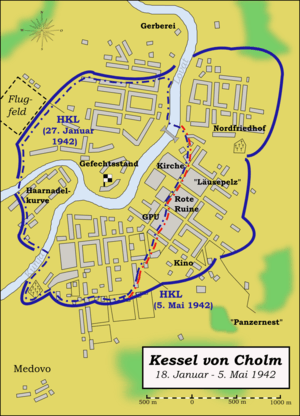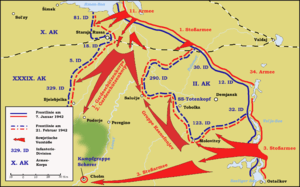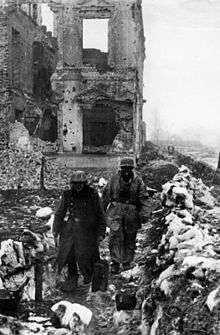Kholm Pocket
| Kholm Pocket | |||||||
|---|---|---|---|---|---|---|---|
| Part of the Eastern Front of World War II | |||||||
 | |||||||
| |||||||
| Belligerents | |||||||
|
|
| ||||||
| Commanders and leaders | |||||||
| Theodor Scherer | Makarjev | ||||||
| Strength | |||||||
|
5,500[1] 18 mortars 10 anti tank guns |
33rd rifle division 391st rifle division 20 tanks | ||||||
| Casualties and losses | |||||||
|
1500 death 2000 wounded | 20 000 | ||||||
The Kholm Pocket (German: Kessel von Cholm; Russian: Холмский котёл) was the name given for the encirclement of German troops by the Red Army around Kholm south of Leningrad, during World War II on the Eastern Front, from 23 January 1942 until 5 May 1942. A much larger pocket was simultaneously surrounded in Demyansk, about 100 km (62 mi) to the northeast. These were the results of German retreat following their defeat during the Battle of Moscow.[1][2]
The air supply of Kholm and Demyansk, while successful, lead to an overconfidence in the German high command in regards to the Luftwaffe's ability to air supply encircled forces which would lead to disastrous consequences at the Battle of Stalingrad in late 1942 and early 1943.[3]
Overview
At the small Kholm pocket, 5,500 German soldiers held it for 105 days. The pocket was supplied by air, but was too small for planes to land; therefore, supplies had to be dropped in and recovered by the German defenders.[4][1] Among the airdropped supplies were 35 of the first 50 prototype MKb 42(H) rifles.[5]
The puzzled together German units trapped at Kholm were mainly part of:[6]
- 218th Infantry Division
- Reserve-Polizei-Bataillon 65
- Infanterie-Regiment 553 (of the 329th Infantry Division)
- Parts of the 123rd Infantry Division
- Jagdkommando 8
- III. Bataillon of the Luftwaffenfeldregiment 1
German forces made three attempts to relieve the pocket, in January, March and May 1942. While the first two failed the third one was successful, with the German forces in the pocket reduced in number to 1,200 by then.[1]
In July 1942, the Cholm Shield was awarded to the German defenders of the pocket, upon the suggestion of Generalmajor Theodor Scherer, similar to the Demyansk Shield.[1][6]
Scherer was personally awarded the Knight's Cross of the Iron Cross with Oak Leaves by Adolf Hitler for the command of the defense of Kholm.[1][6]
Kholm was eventually liberated by the Red Army on 21 February 1944.[1]
War crimes
Members of the Reserve-Polizei-Bataillon 65, a police unit from Gelsenkirchen, were questioned after the war by the state prosecuter in Dortmund for their involvement in ethnic cleansing in Eastern Europe. The unit was found to have taken part in a minimum of 5,000 executions and a large number of deportations to concentration camps. Among them was also the hanging of a young girl in Kholm during the siege.[7]
Gallery
 Offensive of the Red Army south of Lake Ilmen
Offensive of the Red Army south of Lake Ilmen
7 January–21 February 1942 Soldiers in the Kholm Pocket, 1942
Soldiers in the Kholm Pocket, 1942 Soldiers preparing to board a Gotha Go 242 glider, Kholm
Soldiers preparing to board a Gotha Go 242 glider, Kholm Sergeant gives soldier food, right: wounded with head and arm injuries, the end of January - beginning of May 1942
Sergeant gives soldier food, right: wounded with head and arm injuries, the end of January - beginning of May 1942 Soldier sitting for dinner in front of a ruined house
Soldier sitting for dinner in front of a ruined house
References
- 1 2 3 4 5 6 7 Zabecki, p. 695–696
- ↑ Carel, p. 25
- ↑ Bourne, p. 155–156
- ↑ Carel, p. 251–253
- ↑ Rottman, Gordon. The AK-47: Kalashnikov-series assault rifles. Osprey Publishing. p. 9. ISBN 978-1-84908-835-0.
- 1 2 3 Kholm Shield (German) www.lexikon-der-wehrmacht.de, accessed: 16 December 2011
- ↑ Reserve-Polizeibataillon 65 (mot) (German) www.gelsenzentrum.de, accessed: 16 December 2011
Sources
- Zabecki, David (2014). Germany at War: 400 Years of Military History. Santa Barbara, California: ABC-CLIO. ISBN 1598849808.
- Bourne, Merfyn (2013). The Second World War in the Air: The Story of Air Combat in Every Theatre of World War Two. United Kingdom: Troubador Publishing. ISBN 1780884419.
- Carell, Paul (1967). Unternehmen Barbarossa im Bild [Operation Barbarossa in pictures] (in German). Verlag Ullstein. ISBN 3-7766-1709-8.
Further reading
- Richard Muck, Kampfgruppe Scherer–105 Tage im Kessel, (German) published: 1943, reprinted: 2007, publisher: Arndt Verlag, ISBN 978-3-88741-091-9
- Jason D Mark (2011). "Besieged:The Epic Battle for Cholm". Leaping Horseman Books. ISBN 978-0-9751076-9-0.
- Oskars Perro (1992). "Fortress Cholm". Unknown Binding. ASIN: B0012UCHVM
External links
 Media related to Battle of Kholm at Wikimedia Commons
Media related to Battle of Kholm at Wikimedia Commons- Kholm Shield (German) www.lexikon-der-wehrmacht.de
Coordinates: 57°09′N 31°11′E / 57.150°N 31.183°E